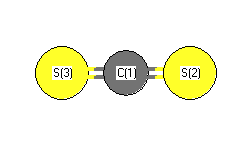.
| squib |
reference |
DOI |
| 1951LB1.3:509 |
Landolt-Bornstein Vol 1 part 3 p509 (1951) |
|
| 1966Herzberg |
Herzberg, G., Electronic spectra and electronic structure of polyatomic molecules,Van Nostrand,New York, 1966 |
|
| 1969Dav/Orv:163 |
PR Davies, WJ Orville-Thomas "Infrared Band Intensities and Bond polaritites Part1. Bond Moment constants in CO2, OCS, CS2, CSe2, and SCSe" J. Mol. Struct. 4 (1969) 163 |
10.1016/0022-2860(69)80052-9 |
| 1997Wat/Cra:1 |
JN Watson, IE Craven, GLD Ritchie "Termperature dependence of electric field-gradient induced birefrigence in carbon dioxide and carbon disulfide" Chem. Phys. Lett. 275 (1997) 1-6 |
10.1016/S0009-2614(97)00656-8 |
| Gurvich |
Gurvich, L.V.; Veyts, I. V.; Alcock, C. B., Thermodynamic Properties of Individual Substances, Fouth Edition, Hemisphere Pub. Co., New York, 1989 |
|
| NSRDS-NBS10 |
R. D. Nelson Jr., D. R. Lide, A. A. Maryott "Selected Values of electric dipole moments for molecules in the gas phase" NSRDS-NBS10, 1967 |
10.6028/NBS.NSRDS.10 |
| Shim |
Shimanouchi, T. , Tables of Molecular Vibrational Frequencies, Consolidated Volu |
10.6028/NBS.NSRDS.39 |
| webbook |
NIST Chemistry Webbook (http://webbook.nist.gov/chemistry) |
10.18434/T4D303 |












